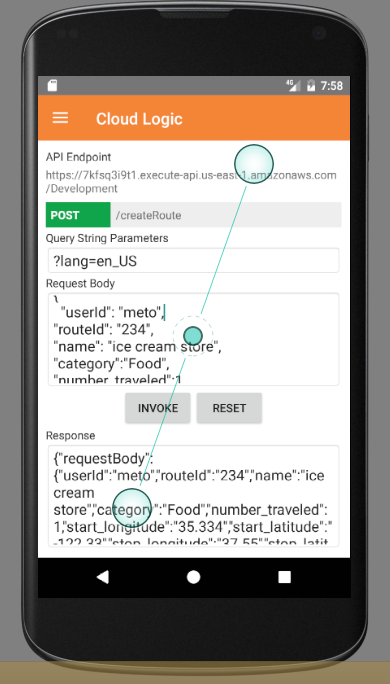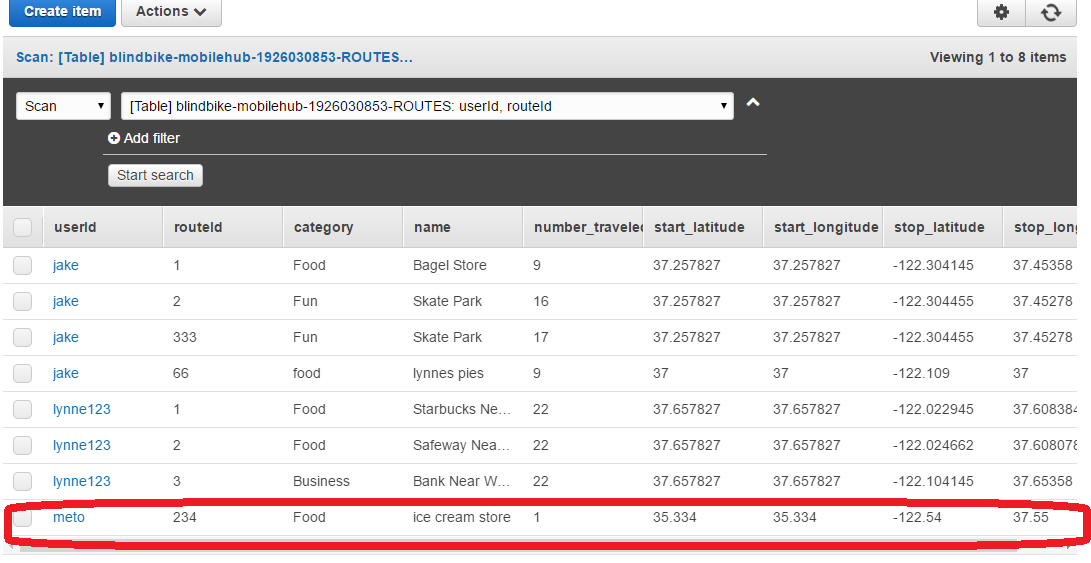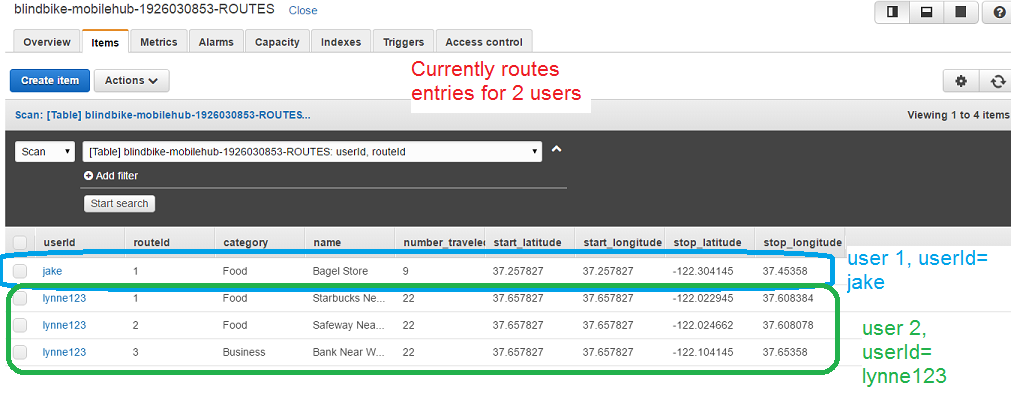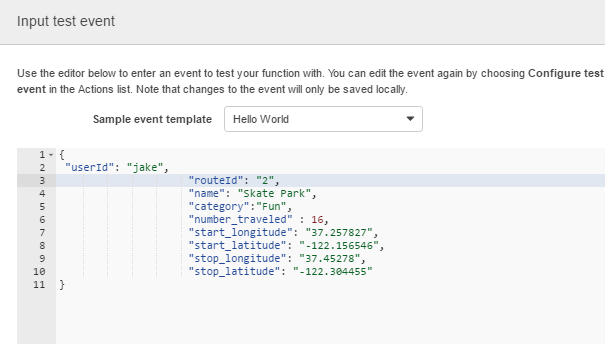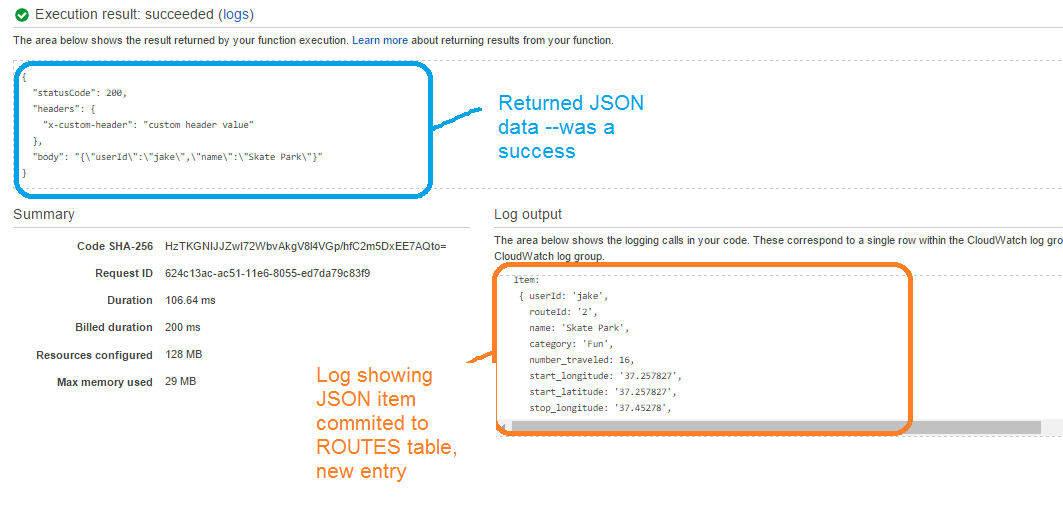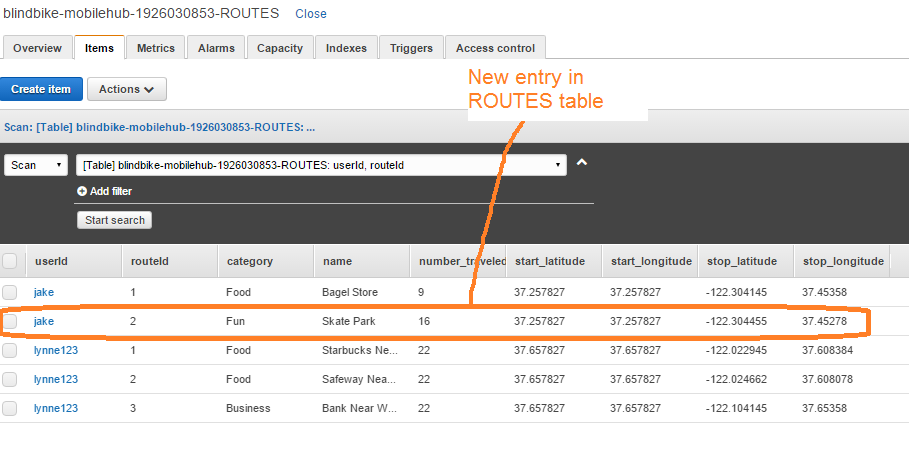CS4521: Mobile and Topics in Web Programming |
||||||
|
Lambda (nodeJS) funciton code for creating route in ROUTES database table
- //STEP 0: setup use of class DynamoDB
- //STEP 1: make a request to insert a new Route into the ROUTES table
- //STEP 2: return if success
- //STEP 3:return if failure
First: Have a database table called ROUTES that contain routes
-
primary key - userId , routeId
-
other columns - name, category, number_traveled, start_longitude, start_latitude, stop_longitude, stop_latitude
Code
special note: uses the AWS class DynamoDB
CODE TO create Route// // Copyright 2016 Amazon.com, Inc. or its affiliates (Amazon). All Rights Reserved. // // Code generated by AWS Mobile Hub. Amazon gives unlimited permission to // copy, distribute and modify it. // 'use strict'; /* This code is used to create a new entry into the Database of bikers for blindBike. Notice that the format is JSON (java script object notation) which is commonly used for data exchange with web services input event example
"Item" : {
"userId": "lynne123",
"routeId": "1",
"name": "Starbuck_Near_Home",
"category":"Food",
"number_traveled" : 22,
"start_longitude": 37.657827,
"start_latitude": -122.056546,
"stop_longitude": 37.427294,
"stop_latitude": -122.149199
}
TODO: extend this code to make sure that the event parameters are not null and pass default values if they
NOTE: date is optional. Should add processing the fields of firstName, lastName and date to complete all of the
values possible in each entry of the biker database table
var doc = require('dynamodb-doc'); //require javascript package for DynamoDB access
var db = new doc.DynamoDB(); //create instance of DynamoDB access object
console.log('Loaded Database Object');
exports.handler = function(event, context, callback) {
var responseCode = 200;
var requestBody, pathParams, queryStringParams, headerParams, stage,
stageVariables, cognitoIdentityId, httpMethod, sourceIp, userAgent,
requestId, resourcePath;
console.log("request: " + JSON.stringify(event));
// Request Body
requestBody = event.body;
console.log("requestbody: " + JSON.stringify(requestBody));
if (requestBody !== undefined && requestBody !== null) {
// Set 'test-status' field in the request to test sending a specific response status code (e.g., 503) responseCode = JSON.parse(requestBody)['test-status']; }// Path Parameters pathParams = event.path;// Query String Parameters queryStringParams = event.queryStringParameters;// Header Parameters headerParams = event.headers; // HTTP Method (e.g., POST, GET, HEAD) httpMethod = event.httpMethod; //********************************************************************************************
//business logic --read in input and create new user entry in ROUTE table
var userId; //get userID from event
var routeId;
var name;
var category;
var number_traveled;
var start_longitude;
var start_latitude;
var stop_longitude;
var stop_latitude;
//IF a PUT method get the JSON data from body and not from event
if(httpMethod !== undefined && (httpMethod == "PUT" || httpMethod == "POST"))
{ console.log("before parse requestBody" + requestBody);
requestBody = JSON.parse(requestBody); //expect input in JSON form
console.log("requestBODY: "+ requestBody);
userId = requestBody.userId; //get userID from event
routeId = requestBody.routeId;
name = requestBody.name;
category = requestBody.category;
number_traveled = parseInt(requestBody.number_traveled);
start_longitude = parseFloat(requestBody.start_longitude);
start_latitude = parseFloat(requestBody.start_latitude);
stop_longitude = parseFloat(requestBody.stop_longitude);
stop_latitude = parseFloat(requestBody.stop_latitude);
}
else if(httpMethod !== undefined && httpMethod == "GET") //if GET method type
{
userId = queryStringParams.userId; //get userID from event
routeId = queryStringParams.routeId;
name = queryStringParams.name;
category = queryStringParams.category;
number_traveled = parseInt(queryStringParams.number_traveled);
start_longitude = parseFloat(queryStringParams.start_longitude);
start_latitude = parseFloat(queryStringParams.start_latitude);
stop_longitude = parseFloat(queryStringParams.stop_longitude);
stop_latitude = parseFloat(queryStringParams.stop_latitude);
}
else //do nothing and let fail if not GET or POST method type in next saftey check
{
userId = event.userId; //get userID from event
routeId = event.routeId;
name = event.name;
category = event.category;
number_traveled = parseInt(event.number_traveled);
start_longitude = parseFloat(event.start_longitude);
start_latitude = parseFloat(event.start_latitude);
stop_longitude = parseFloat(event.stop_longitude);
stop_latitude = parseFloat(event.stop_latitude);
}
//saftey check
if(userId === undefined || routeId === undefined || name === undefined || category === undefined || number_traveled === undefined || start_longitude === undefined || start_latitude === undefined || stop_longitude === undefined || stop_latitude === undefined)
{ console.log("error some input for entry undefined -- failing");
context.fail("could not add new route to ROUTES database table"); }
//this version of code generates the date rather than reading from the event, this could be altered
var datetime = new Date().toString(); // OR can use new Date().getTime().toString();
//simple log to see what is going on.
console.log(userId + "," + routeId + "," + name + "," + category + "," + number_traveled + "," +start_longitude + "," + start_latitude + "," + stop_longitude + "," + start_longitude);
var tableName = "blindbike-mobilehub-1926030853-ROUTES"; //this is the name of YOUR project's dynamoDB table
//this version of the code is creating a data entry only with the required userID and additional password and date
// it is left as future work to add the other fields of firstName and lastName
var item = {
"userId": userId,
"routeId": routeId,
"name": name,
"category": category,
"number_traveled" : number_traveled,
"start_longitude": start_longitude,
"start_latitude": start_longitude,
"stop_longitude": stop_longitude,
"stop_latitude": stop_latitude
};
var params = {
TableName:tableName,
Item: item
};
console.log(params);
console.log("About to create new entry in Database table ROUTES");
//ADD TO database using putItem method - this code is obviously specific to the DynamoDB class that is specific to Lambda
db.putItem(params,function(err,data){
if (err)
{ console.log(err); context.fail("could not add new route to ROUTE database table");
console.log("input to db.put : " + params)
}
else
{ console.log("No error putting to database"); console.log(data);
//*******************************************************************************
// For demonstration purposes, we'll just echo these values back to the client
var responseBody = {
requestBody : requestBody,
pathParams : pathParams,
queryStringParams : queryStringParams,
headerParams : headerParams,
stage : stage,
stageVariables : stageVariables,
cognitoIdentityId : cognitoIdentityId,
httpMethod : httpMethod,
sourceIp : sourceIp,
userAgent : userAgent,
requestId : requestId,
resourcePath : resourcePath,
userId: userId,
name: name
};
var response = {
statusCode: responseCode,
headers: {
"x-custom-header" : "custom header value"
},
body: JSON.stringify(responseBody)
};
console.log("response: " + JSON.stringify(response))
console.log("Database new user entry into ROUTE table completed");
context.succeed(response);
}
});
}; |
Results
we see output as JSON response and LOG shows print out of the multiple routes for user "lynne123" presented as Item JSON formated objects
Here is the testing data
Here is output in console window
Here is entry added properly into ROUTES table
Using AWS generated app to test Cloud logic to test /createRoute path associated with the code
